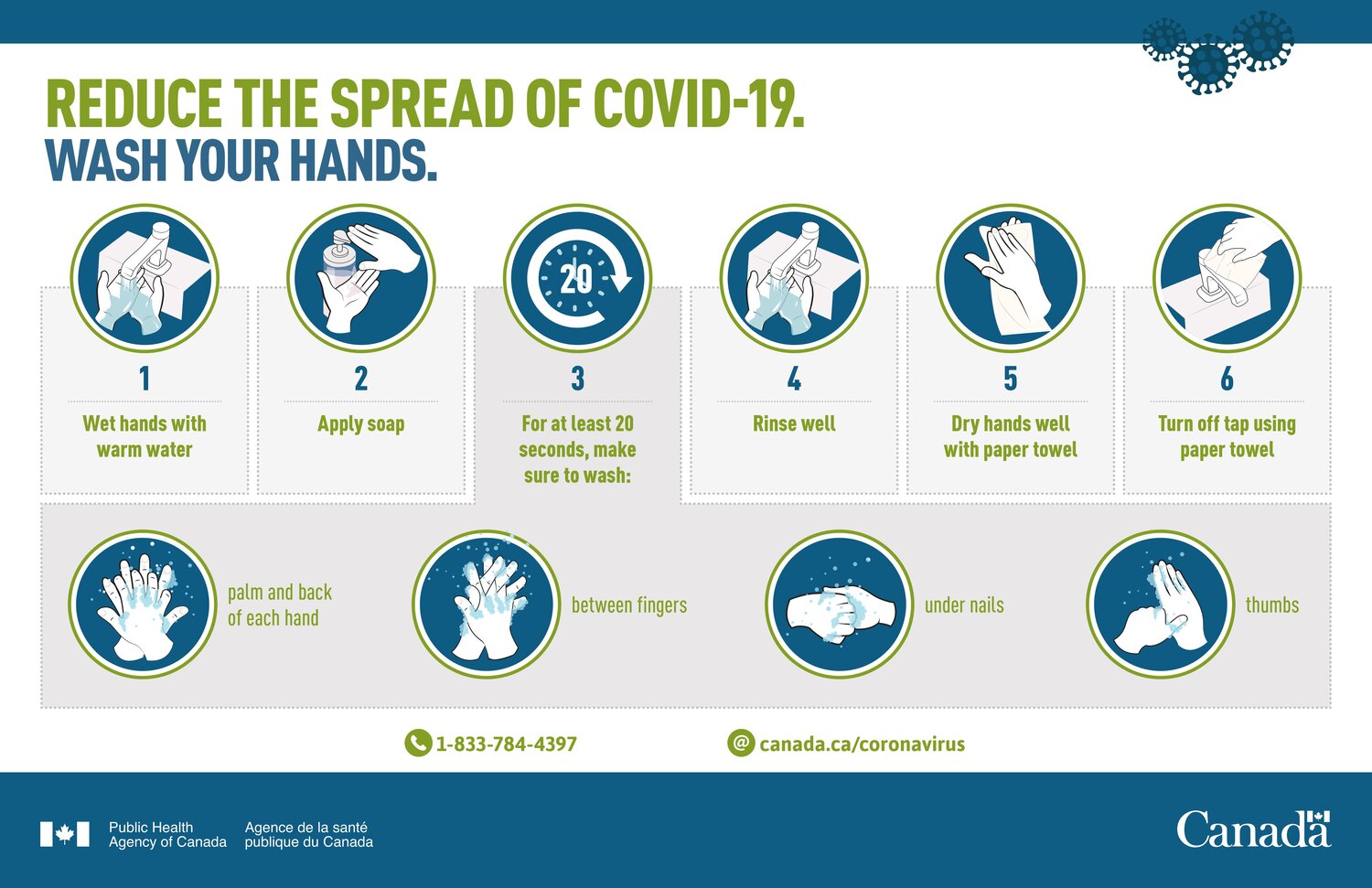Last updated: July 6, 2020. For the most up-to-date information, see the BC Centre for Disease Control, Public Health Agency of Canada, or our Government Resources page
Learn how COVID-19 is spread, how to protect yourself from the virus, and how to navigate disinformation.
Health advice in this section comes from 2 evidence-based, up-to-date online sources of credible public health information: the BC Centre for Disease Control and the Public Health Agency of Canada.
Your friendly C19 Response Coalition team, also known as the people behind this website, is operating in solidarity with and separately from the public health agencies listed above. We provide real-world applications for the public health advice shared throughout this site.
How do I protect myself and others from COVID-19?
The BC Centre for Disease Control recommends taking 4 actions, detailed below, to keep you and your community safe from COVID-19.
Stop the spread of germs
- Do not touch your face, eyes, nose, or mouth with unwashed hands.
- Sneeze or cough into a disposable tissue or your elbow.
- Do not share food, drinks, utensils, etc.
The C19 Response Coalition team says...
We recognize that sharing meals and eating together is an important way for many communities to stay connected at this time. To protect you and your family members from the spread of COVID-19, we recommend that you use serving utensils or serving chopsticks/公筷/gong kuai/gung faai and avoid sharing communal dishes such as hot pot.
Keep your distance from others
- Make sure you are at least 2 metres apart from people outside of your household.
- Avoid crowded places or gatherings including group walks, outdoor exercise, and family gatherings.
- If you live in an apartment or multi-family residence, limit the amount of time you spend in common areas such as laundry rooms. Only use these spaces if you are alone or there is enough space for you to be 2 meters apart from your neighbour.
Wash your hands
Use soap and warm water to wash your hands for at least 20 seconds. The BC Centre for Disease Control states that “soap actively destroys the surface of the virus” and hand washing is the most effective way to prevent the virus from spreading.
Follow the Public Health Agency of Canada’s guide to properly washing your hands below:
The C19 Response Coalition team says…
You might be asking yourself how long it really takes to wash your hands for 20 seconds. Time yourself by humming the “Happy Birthday” song twice. In other languages, our organizers recommend: the first verse of Teresa Teng’s “The Moon Represents My Heart” or “Paru-parong Bukid”.
Clean and disinfect frequently touched surfaces on a regular basis
The BC Centre for Disease Control advises you to use household cleaning products or diluted bleach (see tips on how to make this below) to clean frequently touched surfaces such as doorknobs and electronics.
Tips for safe and effective cleaning:
- Open a window when using disinfectants to keep safe from fumes.
- Wear gloves when you use disinfectants, especially bleach.
- For electronics, follow the manufacturer’s guide on cleaning, or use disinfectant wipes or sprays with at least 70% alcohol.
- Use a Health Canada approved disinfectant. See the regularly updated list of hard-surface disinfectants here.
How do I make my own disinfectant out of bleach?
If you do not have store-bought cleaning products, you can use bleach diluted with room temperature water (DO NOT use hot water). The more diluted the bleach is, the better.
For surfaces in your home:
“If the concentration of bleach on the container is 5.25%, you need 1 part bleach to 99 parts water or 10mL bleach to 990mL water. For other concentrations on the bleach container, use this Foodsafe bleach calculator to make the right dilution.”
-From BC Centre for Disease Control (Retrieved on April 15, 2020)*
For surfaces used in cooking such as countertops and cutting boards:
“Use a more diluted bleach solution: mix 1 part of bleach to 499 parts water or 2mL bleach to 998mL water. Make sure to rinse away bleach solution with water before preparing or serving food.”
-From BC Centre for Disease Control (Retrieved on April 15, 2020)
Be careful! The BC Centre for Disease Control states that you should never mix bleach with vinegar or other acids such as ammonia or rubbing alcohol.
The C19 Response Coalition team says...
The “alcohol percentage” in disinfectants usually refers to the amount of isopropyl alcohol (also known as rubbing alcohol) or ethyl alcohol in the product. This is NOT the same as the alcohol content in alcoholic beverages. Never use whiskey or alcoholic beverages to disinfect your home.
If you are unsure of what to clean with, take a look at Health Canada’s list of approved hard-surface disinfectants.
Personal hygiene
How does COVID-19 spread?
COVID-19 is transmitted through liquid droplets when a person coughs or sneezes. The droplets can enter someone’s eyes, nose, or throat if they are in close contact with an infected person. For example, if you touch a surface that an infected person has recently sneezed on and then blow your nose, you may be transferring infected liquid droplets into a vessel of your respiratory tract and you may be at risk for becoming infected with COVID-19.
The BC Centre for Disease Control states that “these droplets typically spread only one to two metres and quickly fall to the ground”. That is why keeping a distance of at least 2 meters is an important way to prevent the spread of COVID-19.
Important note: the virus is NOT airborne.
Airborne viruses are transmitted through smaller evaporated droplets that we can’t see our touch, or dust particles that we breathe into our throat or lungs. COVID-19 is NOT an airborne virus. It cannot be transmitted through the skin.
Can I wash my hands with alcohol-based hand sanitizer?
Alcohol-based hand sanitizer or hand rubs should only be used if soap and water are not available. To effectively clean your hands with alcohol-based hand sanitizer, make sure to wipe any visible debris from your hands first, then apply the sanitizer.
Be careful! Which alcohol hand sanitizers can I use?
The BC Centre for Disease Control and Health Canada warns against using homemade hand sanitizers.
Only use hand sanitizers that are:
- Approved by Health Canada. See the official list here.
- Have at least 60% alcohol concentration.
Be careful! Health Canada warns against making your own hand sanitizer as homemade formulas may be ineffective at killing the coronavirus that causes COVID-19. It may also present health risks such as skin irritation, increased sensitivity, or allergies.
“Health Canada does not recommend making your own hand sanitizer, no matter what the recipe is.” Even formulas published by credible sources such as the World Health Organization are not suitable to create at home. These hand sanitizer formulas are meant for licensed producers which have the proper manufacturing environment and ingredients to create a safe and effective product.
Masks
Updated: July 6, 2020.
Information and resources about masks are provided by our coalition member, Bảo Vệ Collective. Additional edits have been made by the C19 Response Coalition team to provide updated information on mask types.
Should I wear a mask?
Healthy individuals are not required to wear a mask in public. It can, however, be an additional measure that you can take to protect others around you, particularly in instances in which physical distancing is not possible.
Masks should not be worn by:
- Children under 2 years old.
- Anybody who has trouble breathing.
- Anybody who cannot remove masks without assistance.
How to wear masks safely
- Ensure the mask or face covering is clean and dry.
- Wash your hands with warm water and soap for at least 20 seconds before touching the mask. If none is available, use hand sanitizer with a minimum 60% alcohol base.
- Ensure your hair is away from your face and place the face covering over your nose and mouth.
- Secure the elastic loops around your ears. If your mask has strings, tie them securely behind your head.
- Ensure that your nose and mouth are fully covered. Your mask should fit snugly to your cheeks and leave no gaps between your face. Adjust if needed.
- Wash your hands with water and soap for at least 20 seconds, or use hand sanitizer with a minimum 60% alcohol base.
- Do not touch the front of the mask while you wear it.
Click here to watch the Government of Canada’s instructional video on how to wear a non-medical mask or face covering properly.
Masks or face coverings should not:
- Be secured with tape or other inappropriate materials.
- Impair vision or interfere with tasks.
- Be shared with others. Have your own designated mask.
Masks or face coverings should:
- Be comfortable and not require frequent adjustment.
- Be changed as soon as possible if damp or dirty.
- Fit securely to the head with ties or ear loops
Can I reuse my mask?
The Public Health Agency of Canada states that non-medical masks that cannot be washed should be properly thrown away in a garbage bin once they get damp, soiled, or crumbled. Cloth masks should be washed with hot water and detergent once they are damp or soiled.
How do I safely dispose of my mask?
Do not reuse medical-masks. Make sure to properly dispose them after use.
When taking off your mask, you must:
- Wash your hands with warm water and soap for at least 20 seconds. If none is available, use hand sanitizer with a minimum 60% alcohol base.
- Remove the face covering by un-tying it or removing the loops from your ears. Avoid touching the front of the mask.
- For medical masks, dispose in a garbage bin or plastic bag. For reusable cloth masks, wash your mask with hot soapy water or with your laundry before wearing again.
- Wash your hands with water and soap for at least 20 seconds or use hand sanitizer with a minimum of 60% alcohol base.
Remember!
- If your medical mask becomes damp during use, replace it with a new one.
- If you are unable to safely dispose of your mask, you can temporarily place the mask in a plastic bag. Make sure you close or zip seal the bag while being stored.
- Masks are helpful but are NOT a replacement for proven measures to prevent COVID-19, such as thorough hand washing, physical distancing, and covering your mouth when coughing or sneezing.
Which type of mask should I wear?
Updated: July 6, 2020.
Information and resources about masks are provided by our coalition member, Bảo Vệ Collective. Additional edits have been made by the C19 Response Coalition team to provide updated information on mask types.
Each mask type is designed for an intended user and use. The BC Centre for Disease Control and World Health Organization (WHO) provide recommendations, detailed below, for when certain types of masks should be worn and who should wear them.
Non-medical masks (cloth masks and face coverings)
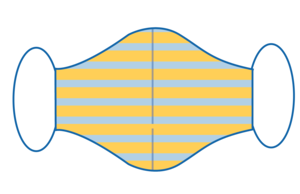
- Made from a variety of materials, like cloth. The BC Centre for Disease control recommends 100% cotton masks. Are often reusable and can be washed.
- May be used to reduce the spread of large respiratory droplets. The WHO states that cloth masks offer minimal protection to the wearer.
Who should wear them?
- People who do not have COVID-19 symptoms and cannot maintain physical distance from others in public.
- For example, people working in close contact with others, including social workers, cashiers and servers.
When should they be worn?
- In places where control measures and physical distancing cannot be achieved, such as public transport, in shops, grocery stores, workplaces, and other crowded environments.
- When medical masks are not available, especially for those providing care to COVID-19 patients at home.
Tips to care for your cloth mask:
- If your fabric mask is not dirty or wet and you plan to reuse it, put it in a clean plastic, resealable bag. If you need to use it again, hold the mask at the elastic loops when removing it from the bag to avoid touching the outside of the mask.
- Wash fabric masks in soap or detergent and hot water (at least 60°C) at least once a day.
- If hot water is not available, wash the mask in soap/detergent and room-temperature water, followed by either boiling the mask for 1 minute OR; by soaking the mask in 0.1% chlorine for 1 minute and thoroughly rinsing the mask with room temperature water (there should not be any toxic residue of chlorine on the mask).
- Make sure you have your own mask and do not share it with others.
Can I use a homemade cloth mask?
The BC Centre for Disease Control recommends using homemade masks if you show symptoms of COVID-19 or are taking care of someone with COVID-19 symptoms and cannot buy commercial masks.
What makes a good homemade mask?
Here are some tips for making effective masks:
- “Some materials are better than others. Use clean and stretchy 100% cotton t-shirts or pillowcases.
- Ensure the mask fits tightly around the nose and mouth; material that allows droplets to pass through will not work.
- The mask should be comfortable, or you won’t want to wear it consistently.
- If the mask makes it a lot harder to breathe, then the seal will not be as good, and the mask will be less effective.
- Clean or change the mask often.”
-From BC Centre for Disease Control (Retrieved on April 15, 2020) Learn how to make your own cloth mask from the Public Health Agency of Canada. No sewing skills required!
Tips to wear your homemade mask safely and effectively
- “You must wash your hands immediately before putting it on and immediately after taking it off (in addition to practicing good hand hygiene while wearing it)
- Change a cloth mask as soon as it gets damp or soiled
- Put it directly into the washing machine or a bag that can be emptied into the washing machine and then disposed of
- Cloth masks can be laundered with other items using a hot cycle, and then dried thoroughly.”
-From Public Health Agency of Canada (Retrieved on April 15, 2020)
Medical masks (also known as surgical or medical procedural masks)
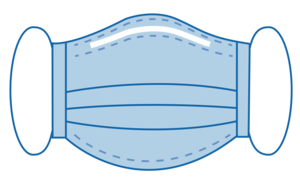
- Made from a minimum of three layers of synthetic nonwoven materials, and configured to have filtration layers sandwiched in the middle.
- Available in different thicknesses, with various levels of fluid resistance and two levels of filtration.
- Used to stop droplets from the wearer’s mouth and nose from coming in contact with others and the environment.
- Used to prevent transmission of the virus from others to the wearer.
- Meant for one-time use.
Who should use them?
- Health care workers and others providing direct care to COVID-19 patients. The BC Centre for Disease Control advises that “medical masks should be reserved for healthcare workers.”
- People with COVID-19 symptoms. To learn about the symptoms of COVID-19, see our Symptoms and Managing COVID-19 page.
- Those who are taking care of someone with COVID-19 symptoms.
- Seniors over the age of 60 years old who cannot maintain physical distance from others.
- People with underlying health conditions (e.g. diabetes, heart disease, and lung disease), who cannot maintain physical distance from others.
Medical Respirators (N95, Filtering Facepiece Respirators (FFP), FFP2, FFP3, N99)
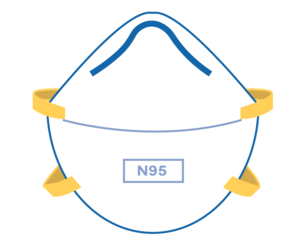
- Specifically designed for healthcare workers who provide care to COVID-19 patients in settings and areas where aerosol generating procedures are undertaken.
- Used to protect the wearer from inhaling and exhaling very small airborne particles and aerosols.
- Designed to fit closely over the nose and mouth to form a tight seal.
- Must be custom fit and worn properly in order to be effective.
Who should use them?
- Healthcare workers in healthcare settings. The BC Centre for Disease Control advises that “N95 respirators should be reserved for healthcare workers.”
- NOT for use by the general public because they need to be custom fitted to be effective.
Industrial Respirators
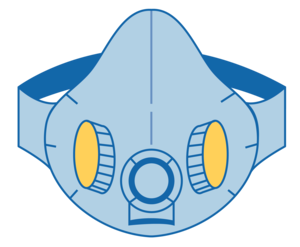
- Used to protect workers from inhaling dust, fumes, and hazardous aerosols.
- The BC Centre for Disease Control does not recommend industrial respirators for COVID-19 prevention because if they have a valve and you cough/sneeze, you may spread a stream of germs through the valve.
Who should use them?
- Industrial Respirators should not be used as protection against COVID-19.
More information
Be careful of disinformation
Information on how to stay safe from COVID-19 is rapidly evolving as health experts and government agencies learn more about this new virus.
Currently, the Public Health Agency of Canada has “not approved any product to prevent, treat or cure COVID-19.”
The internet is full of useful information, but there are also many false, potentially harmful myths circulating about COVID-19. Learn more about how to assess the credibility of COVID-19 information with our What's real and what's fake guide.
Learn More
- The BC Centre for Disease Control has the most credible information on the prevention of COVID-19 and personal hygiene for residents of British Columbia.
References
Pages are in order of appearance.
- BC Centre for Disease Control
- Prevention & Risks. Retrieved on April 13, 2020.
- Masks. Retrieved on April 15, 2020.
- Hand washing. Retrieved on April 13, 2020.
- Cleaning and Disinfecting. Retrieved on April 15, 2020.
- How it Spreads. Retrieved on April 15, 2020.
- Face masks: how are they different? Published on May 26, 2020. Retrieved on June 23, 2020.
- Health Canada:
- Homemade hand sanitizers may present health risks. Published April 2, 2020. Retrieved on April 13, 2020.
- Hard-surface disinfectants and hand sanitizers (COVID-19): List of hard-surface disinfectants. Retrieved on April 22, 2020.
- Hard-surface disinfectants and hand sanitizers (COVID-19): List of hand sanitizers authorized by Health Canada. Retrieved on April 15, 2020.
- Public Health Agency of Canada:
- Coronavirus disease (COVID-19): Reduce the spread of COVID-19 – Wash your hands. Published March 2020. Retrieved on April 15, 2020.
- About non-medical masks and face coverings. Retrieved April 16, 2020.
- Coronavirus disease (COVID-19): Prevention and risks. Retrieved April 16, 2020.
- World Health Organization
- Coronavirus disease (COVID-19) advice for the public: When and how to use masks. Retrieved on June 23, 2020.
- Q&A: Masks and COVID-19. Retrieved on June 23, 2020.
